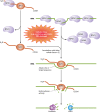Intrusion of a DNA repair protein in the RNome world: is this the beginning of a new era?
- PMID: 19901076
- PMCID: PMC2798471
- DOI: 10.1128/MCB.01174-09
Intrusion of a DNA repair protein in the RNome world: is this the beginning of a new era?
Abstract
Apurinic/apyrimidinic endonuclease 1 (APE1), an essential protein in mammals, is known to be involved in base excision DNA repair, acting as the major abasic endonuclease; the protein also functions as a redox coactivator of several transcription factors that regulate gene expression. Recent findings highlight a novel role for APE1 in RNA metabolism. The new findings are as follows: (i) APE1 interacts with rRNA and ribosome processing protein NPM1 within the nucleolus; (ii) APE1 interacts with proteins involved in ribosome assembly (i.e., RLA0, RSSA) and RNA maturation (i.e., PRP19, MEP50) within the cytoplasm; (iii) APE1 cleaves abasic RNA; and (iv) APE1 cleaves a specific coding region of c-myc mRNA in vitro and influences c-myc mRNA level and half-life in cells. Such findings on the role of APE1 in the posttranscriptional control of gene expression could explain its ability to influence diverse biological processes and its relocalization to cytoplasmic compartments in some tissues and tumors. In addition, we propose that APE1 serves as a "cleansing" factor for oxidatively damaged abasic RNA, establishing a novel connection between DNA and RNA surveillance mechanisms. In this review, we introduce questions and speculations concerning the role of APE1 in RNA metabolism and discuss the implications of these findings in a broader evolutionary context.
Figures

Similar articles
-
APE1/Ref-1 interacts with NPM1 within nucleoli and plays a role in the rRNA quality control process.Mol Cell Biol. 2009 Apr;29(7):1834-54. doi: 10.1128/MCB.01337-08. Epub 2009 Feb 2. Mol Cell Biol. 2009. PMID: 19188445 Free PMC article.
-
Human apurinic/apyrimidinic endonuclease 1 (APE1) has 3' RNA phosphatase and 3' exoribonuclease activities.J Mol Biol. 2015 Jan 30;427(2):298-311. doi: 10.1016/j.jmb.2014.12.001. Epub 2014 Dec 10. J Mol Biol. 2015. PMID: 25498387
-
Altered endoribonuclease activity of apurinic/apyrimidinic endonuclease 1 variants identified in the human population.PLoS One. 2014 Mar 4;9(3):e90837. doi: 10.1371/journal.pone.0090837. eCollection 2014. PLoS One. 2014. PMID: 24595156 Free PMC article.
-
Molecular Mechanisms Regulating the DNA Repair Protein APE1: A Focus on Its Flexible N-Terminal Tail Domain.Int J Mol Sci. 2021 Jun 11;22(12):6308. doi: 10.3390/ijms22126308. Int J Mol Sci. 2021. PMID: 34208390 Free PMC article. Review.
-
AP Endonuclease 1 as a Key Enzyme in Repair of Apurinic/Apyrimidinic Sites.Biochemistry (Mosc). 2016 Sep;81(9):951-67. doi: 10.1134/S0006297916090042. Biochemistry (Mosc). 2016. PMID: 27682167 Review.
Cited by
-
Crystallization and preliminary X-ray analysis of human endonuclease 1 (APE1) in complex with an oligonucleotide containing a 5,6-dihydrouracil (DHU) or an alpha-anomeric 2'-deoxyadenosine (alphadA) modified base.Acta Crystallogr Sect F Struct Biol Cryst Commun. 2010 Jul 1;66(Pt 7):798-800. doi: 10.1107/S1744309110017021. Epub 2010 Jun 24. Acta Crystallogr Sect F Struct Biol Cryst Commun. 2010. PMID: 20606276 Free PMC article.
-
BRCA1 modulates the expression of hnRNPA2B1 and KHSRP.Cell Cycle. 2010 Dec 1;9(23):4666-73. doi: 10.4161/cc.9.23.14022. Epub 2010 Dec 1. Cell Cycle. 2010. PMID: 21099359 Free PMC article.
-
Coordination of MYH DNA glycosylase and APE1 endonuclease activities via physical interactions.DNA Repair (Amst). 2013 Dec;12(12):1043-52. doi: 10.1016/j.dnarep.2013.09.007. Epub 2013 Oct 24. DNA Repair (Amst). 2013. PMID: 24209961 Free PMC article.
-
Combined inhibition of Ref-1 and STAT3 leads to synergistic tumour inhibition in multiple cancers using 3D and in vivo tumour co-culture models.J Cell Mol Med. 2021 Jan;25(2):784-800. doi: 10.1111/jcmm.16132. Epub 2020 Dec 3. J Cell Mol Med. 2021. PMID: 33274592 Free PMC article.
-
In Vitro Assay to Measure APE1 Enzymatic Activity on Ribose Monophosphate Abasic Site.Methods Mol Biol. 2023;2701:21-38. doi: 10.1007/978-1-0716-3373-1_2. Methods Mol Biol. 2023. PMID: 37574473
References
-
- Aas, P. A., M. Otterlei, P. O. Falnes, C. B. Vågbø, F. Skorpen, M. Akbari, O. Sundheim, M. Bjørås, G. Slupphaug, E. Seeberg, and H. E. Krokan. 2003. Human and bacterial oxidative demethylases repair alkylation damage in both RNA and DNA. Nature 42:859-863. - PubMed
-
- Barzilay, G., C. D. Mol, C. N. Robson, L. J. Walker, R. P. Cunningham, J. A. Tainer, and I. D. Hickson. 1995. Identification of critical active-site residues in the multifunctional human DNA repair enzyme HAP1. Nat. Struct. Biol. 2:561-568. - PubMed
Publication types
MeSH terms
Substances
Grants and funding
LinkOut - more resources
Full Text Sources
Research Materials
Miscellaneous
